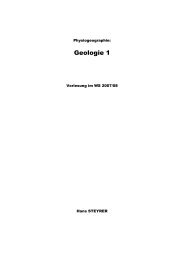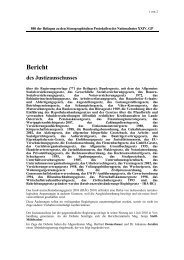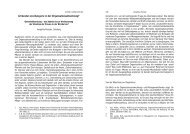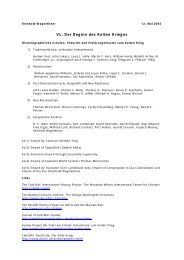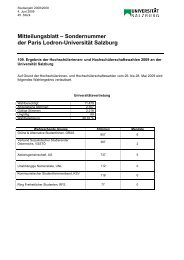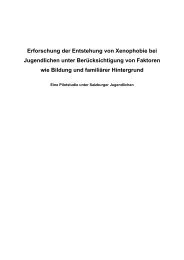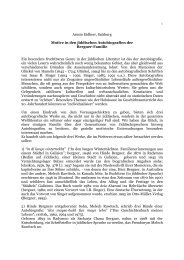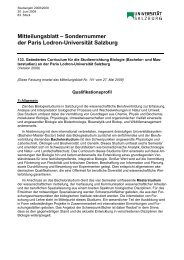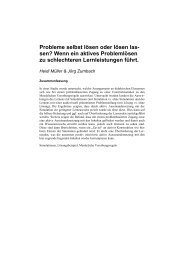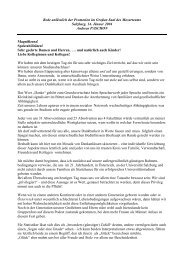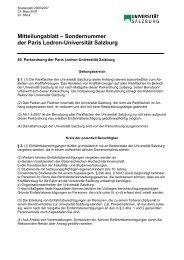Klima im Wandel Climate Change - Universität Salzburg
Klima im Wandel Climate Change - Universität Salzburg
Klima im Wandel Climate Change - Universität Salzburg
Erfolgreiche ePaper selbst erstellen
Machen Sie aus Ihren PDF Publikationen ein blätterbares Flipbook mit unserer einzigartigen Google optimierten e-Paper Software.
Wie alt sind Blockgletscher in den Österreichischen Alpen?<br />
Das Beispiel der Blockgletscher <strong>im</strong> Dösener Tal, Ankogelgruppe,<br />
datiert mit Hilfe der Schmidt-Hammer Methode<br />
Andreas Kellerer-Pirklbauer<br />
Institut für Geographie und Raumforschung, Karl-Franzens-Universität Graz<br />
Abstract<br />
What is the age of rock glaciers in the Austrian Alps? The example of the rock glaciers<br />
in the Dösen Valley, Ankogel Mountains, dated by the Schmidt-hammer method.<br />
Active rock glaciers are common large-scale flow features originating from thick debris<br />
accumulations (talus and/or till) in high-relief environments which are under permafrost<br />
conditions for a substantial period of t<strong>im</strong>e. Rock glaciers are characteristic landforms in<br />
mountain permafrost environments. More than one thousand rock glaciers formed in the<br />
Austrian Alps after the retreat of the Pleistocene glacier systems. Today, most of these rock<br />
glaciers are relict features without any ice content but still with the typical surface topography<br />
which makes them easy to identify in the field. These relict features indicate former permafrost<br />
conditions. Rock glaciers need hundreds to thousands of years to form, thus, datings on rock<br />
glaciers provide valuable information on palaeocl<strong>im</strong>atic conditions. This paper presents datings<br />
on three rock glaciers (containing permafrost) in the Dösen Valley, Ankogel Mountains, Hohe<br />
Tauern Range, derived with the Schmidt-hammer method. Results of this approach as well as<br />
additional palaeocl<strong>im</strong>atic information show that all three rock glaciers are old landforms. Their<br />
formation started already in the early Holocene. The largest of the three rock glaciers was<br />
constantly active during the last (at least) 8400 years. This indicates that permafrost conditions<br />
were present during this entire period in the Dösen Valley at elevations above 2350 m a.s.l and<br />
at coarse debris slopes facing west to north. S<strong>im</strong>ilar long formation periods can be assumed<br />
for many of the other Austrian rock glaciers. Additional relative and absolute datings on rock<br />
glaciers in Austria could help to validate the results from the Dösen valley as well as <strong>im</strong>prove<br />
the understanding of rock glacier formation in the Austria during the last thousands of years.<br />
Zusammenfassung<br />
Blockgletscher sind lappen- bis zungenförmige Eis- und Schuttgemische, die sich lavastromartig<br />
langsam hang- oder talabwärts bewegen. Sie gelten als typisches Landschaftselement des alpinen<br />
Permafrosts (Dauerfrost). In den österreichischen Alpen haben sich nach dem Rückzug der<br />
Gletscher am dem Ende der letzten Eiszeit über tausend solcher Blockgletscherformen gebildet.<br />
Die meisten dieser Blockgletscher sind heute eisfrei und somit Zeugnis früherer Permafrostbedingungen.<br />
Bedenkt man, dass Blockgletscher für ihre Entwicklung hunderte bis tausende<br />
von Jahren mit Permafrostbedingungen benötigen, wird klar, dass Datierungen mit Bezug zur<br />
alpine space - man & environment, vol. 6: <strong>Kl<strong>im</strong>a</strong>wandel in Österreich<br />
© 2009 iup • innsbruck university press, ISBN 978-3-902571-89-2




